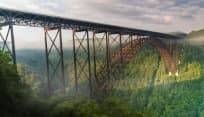The many moods of the Cheat River (and when’s best to ride!)
The Cheat River is one of the longest free-flowing paddling destinations in the east, and northern West Virginia’s premier aquatic playground.
The Cheat’s an outstanding natural and recreational resource as it flows unrestricted from its headwaters to its only dam at Cheat Lake near Morgantown. It’s conveniently broken up into 3 distinct sections of advancing difficulty and adventure. From the calm flatwater of the Upper Cheat, to the heart-pounding rapids of the Cheat Canyon, the river’s personality is as unique as the land it traverses.
World-class paddlers and dedicated conservationists alike have made the Cheat River watershed their home, so gather your crew, grab a paddle, and come find out why.
Upper Cheat River Water Trail
The Upper Cheat River Water Trail (UCRWT) has 9 river access points,  with nearly 40 miles of pristine paddling through calm, deep pools and wide, shallow riffles. This section, starting in Hendricks and ending at the quaint river town of Rowlesburg, has only a few class I and II rapids to navigate, so the UCRWT is perfect for novice paddlers, family trips and overnighters with a canoe full of camping gear and fishing poles.
with nearly 40 miles of pristine paddling through calm, deep pools and wide, shallow riffles. This section, starting in Hendricks and ending at the quaint river town of Rowlesburg, has only a few class I and II rapids to navigate, so the UCRWT is perfect for novice paddlers, family trips and overnighters with a canoe full of camping gear and fishing poles.
Home to both native and stocked trout, the Cheat is also well-known for its fly fishing. The UCRWT is free, and you don’t need any permits for overnight trips, although you do need a valid West Virginia fishing license if you want to cast your line.
You can run the UCRWT at most levels, but it’s ideal at 500-1,000 cubic feet per second (cfs), and the levels start to drop as summer goes on. Always check the water level before you head out.
Cheat Narrows
Once you get past Rowlesburg, the river’s calm and forgiving demeanor begins to change as the wide valleys close in, creating the Cheat Narrows. Characterized by 5 miles of class II and III rapids with fun wave trains and a few technical moves around boulders, the Narrows is the ideal training run to perfect your paddling skills.
The run is highlighted by Calamity Rock, a class III+ rapid where the river is squeezed to the right of (or over, during high flows) a massive boulder. The Narrows is great for smaller rafts, shredders, duckies and kayaks, though hardy locals run the rapids in canoes.
You can raft the Narrows when it is above 500 cfs, up to 10,000 cfs. Above 10 grand, the river becomes a steady stream of class V-VI rapids, and is for expert paddlers only. WV-72 runs directly parallel to the Narrows, so you have quite a few convenient put-in and take-out options.
Cheat Canyon
Downstream from Kingwood, the Cheat widens and slows before reaching the town of Albright. But don’t be fooled— from the mouth of Muddy Creek at the Friends of the Cheat (FOC) River Festival site and section put-in, the river drops and thrashes through the legendary Cheat Canyon. Here, you’ll have to maneuver 9.5 intense miles of class III-V rapids, including the 3-tiered Coliseum Rapids. This section tests the grit of the most adventurous paddlers as the frothing Cheat tumbles past thick old-growth forest and sheer sandstone cliffs.
The Friends of the Cheat (FOC) and the Nature Conservancy bought the 1,400-square-mile section of Cheat watershed, along with the canyon, as a nature preserve in 2014 to protect its wild and scenic nature for generations to come. Being able to paddle a truly wild and scenic river with no visible road is one of the Cheat’s best qualities, and it’s even home to several endangered species.
The canyon’s rugged nature means it is strictly for expert paddlers with self-rescue skills. If in doubt, hire a guide through one of the region’s whitewater outfitters. You can typically run the canyon between 11 and 15 feet (corresponding to roughly 1-5 feet, respectively, at the Power Bridge Gauge.)
The river’s unregulated status means that water levels change quickly and often, so always check the river gauges on the day of your trip. A quick storm up in the Cheat’s headwaters can cause a rise of several feet in the Narrows and Canyon sections in the same day.
This post was last updated on April 24, 2023








